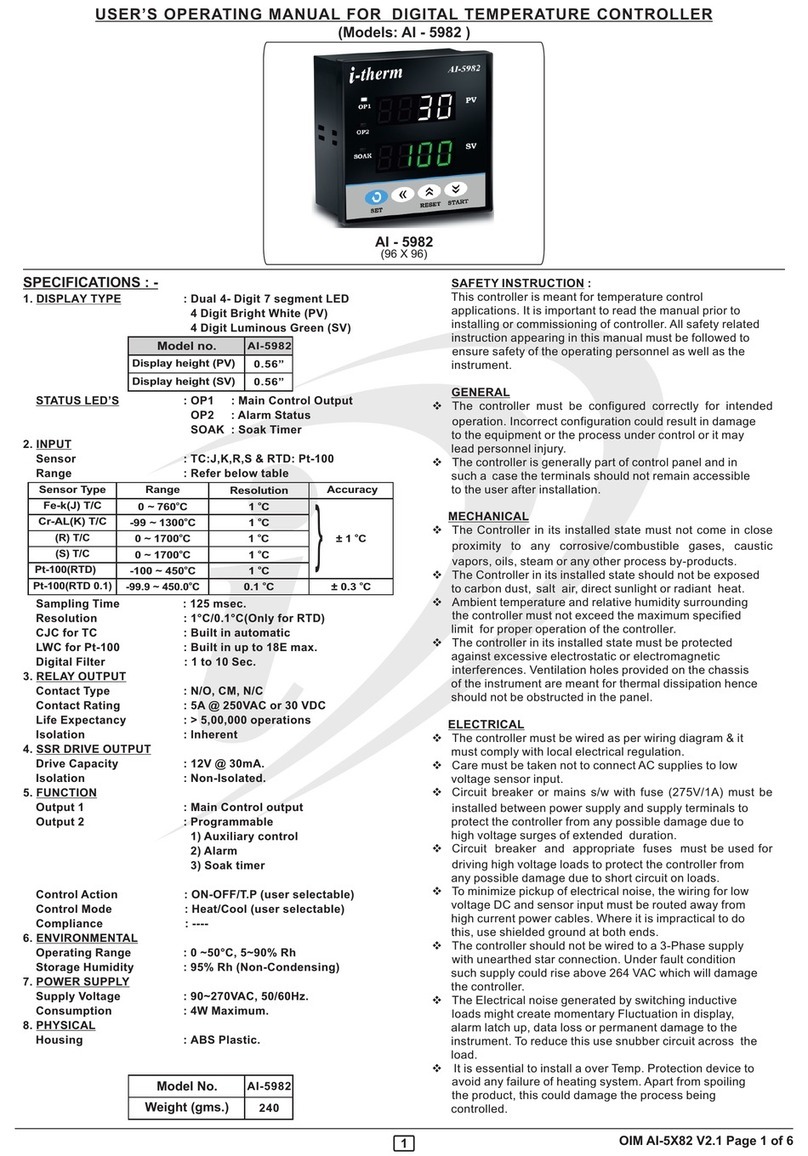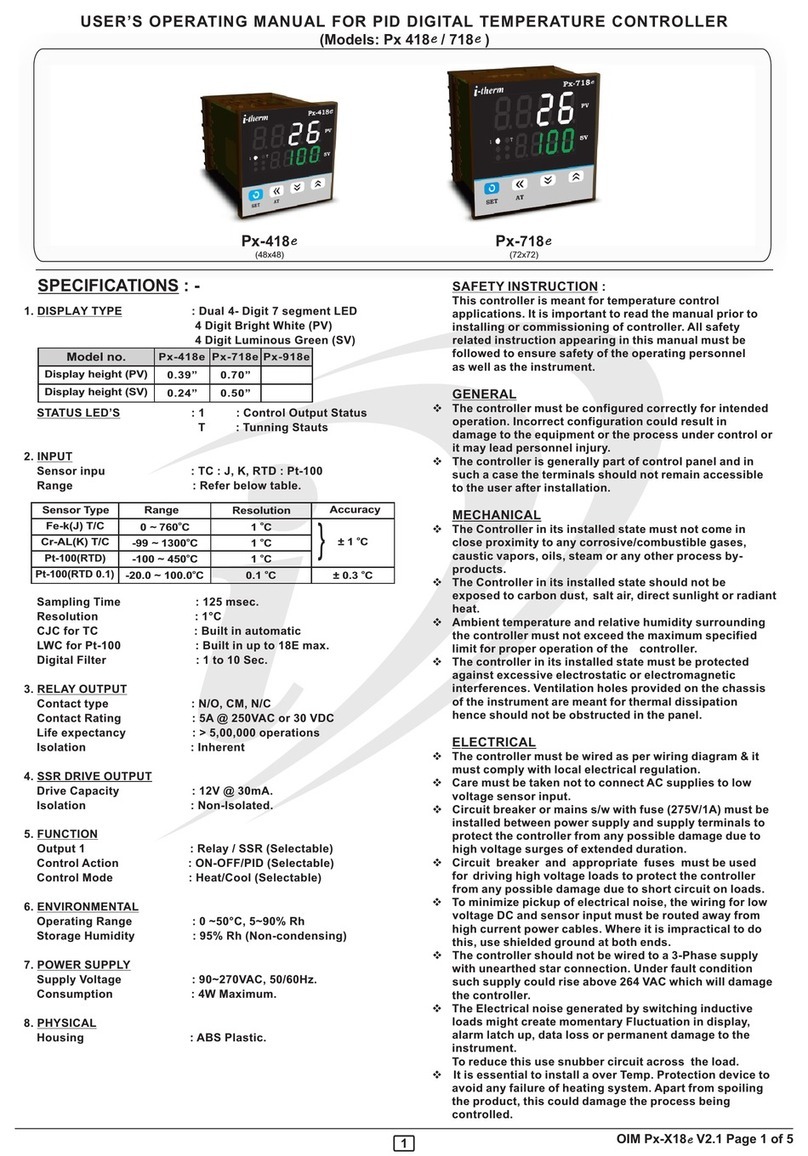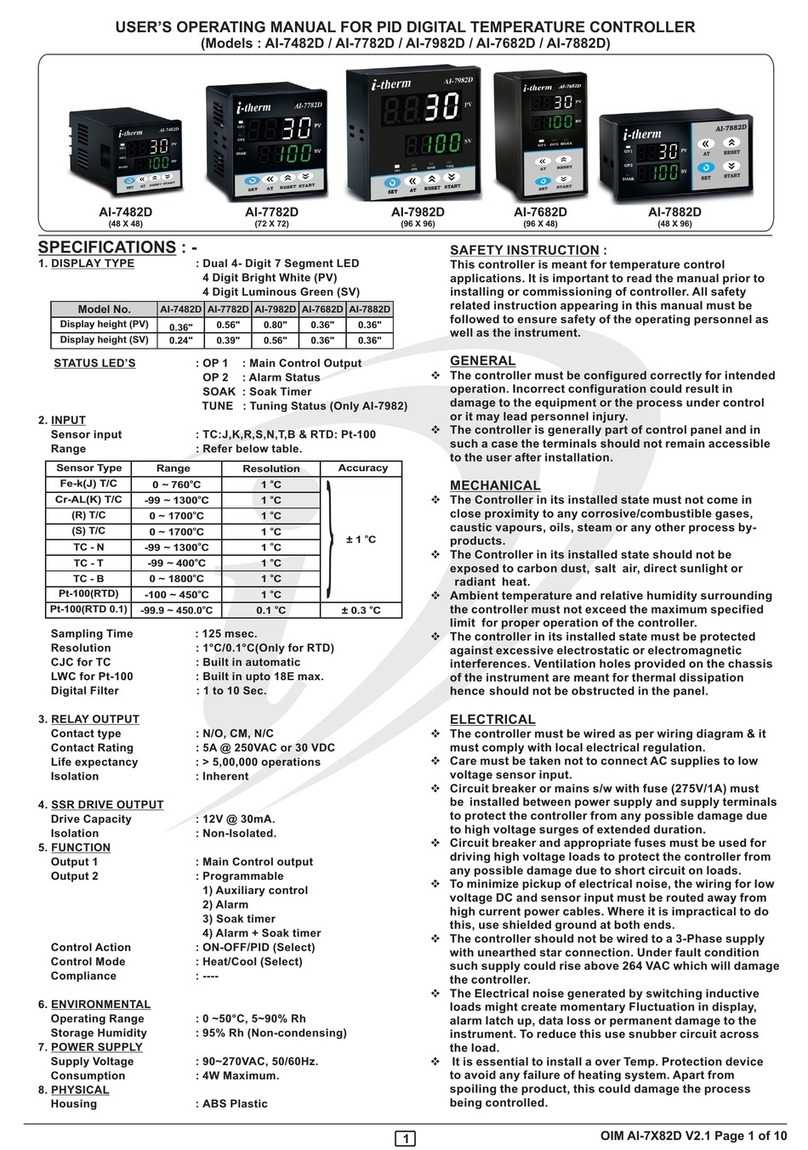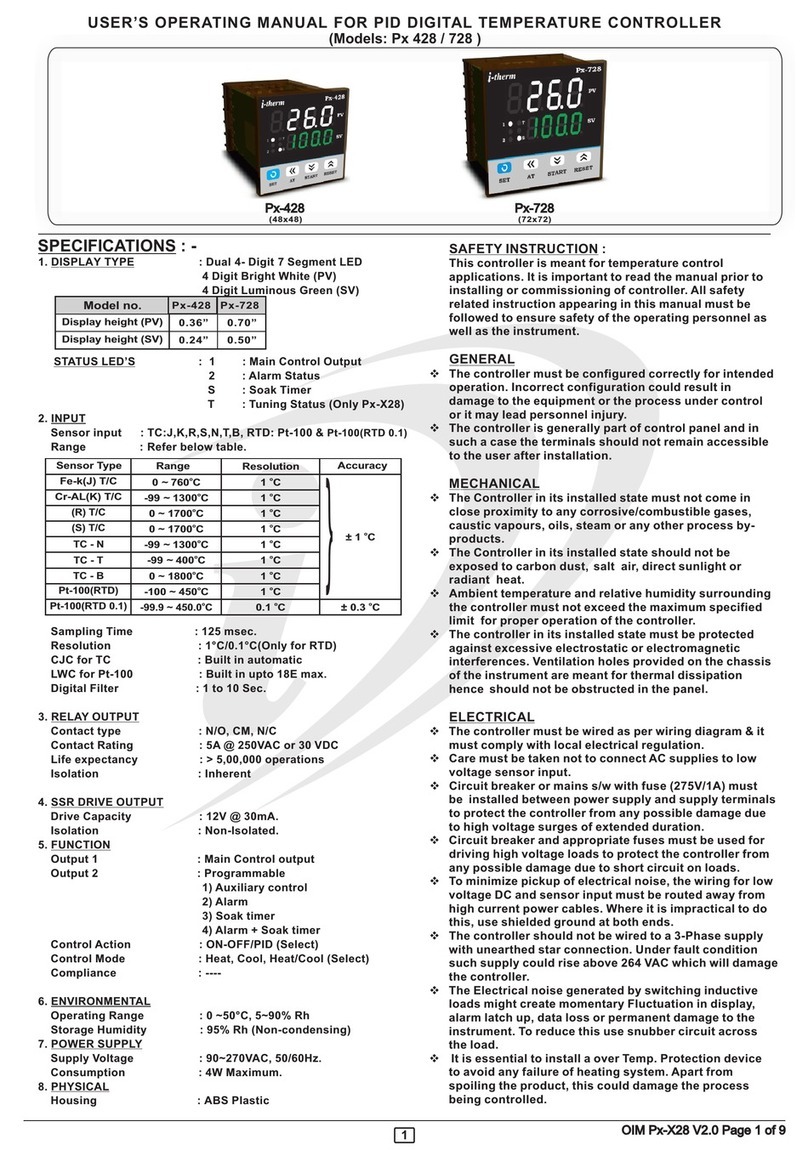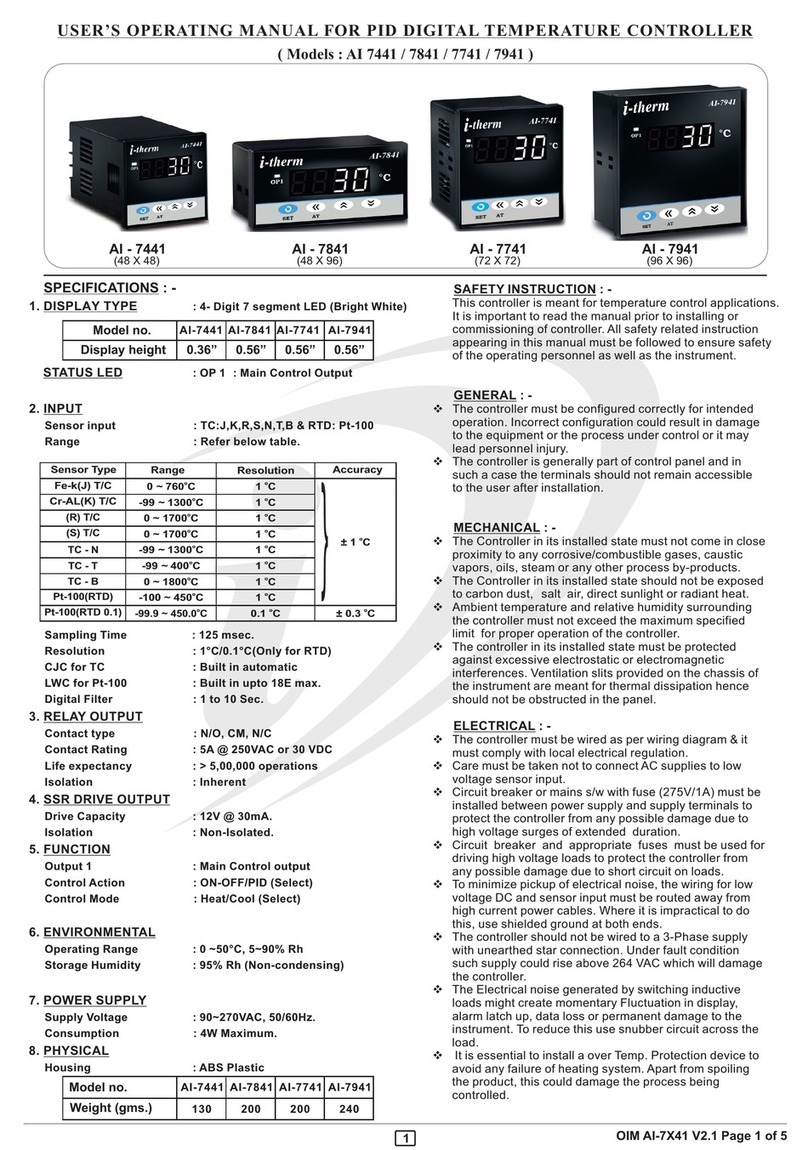
i
(48 X 48)
AI-7482 AI-7782
(72 X 72)
AI-7982
(96 X 96)
AI-7882
(48 X 96)
1. DISPLAY TYPE : Dual 4- Digit 7 Segment LED
4 Digit Bright White (PV)
4 Digit Luminous Green (SV)
STATUS LED’S : OP 1 : Main Control Output
OP 2 : Alarm Status
SOAK : Soak Timer
TUNE : Tuning Status (Only AI-7982)
2. INPUT
Sensor input : TC:J,K,R,S,N,T,B & RTD: Pt-100
Range : Refer below table.
Sampling Time : 125 msec.
Resolution : 1°C/0.1°C(Only for RTD)
CJC for TC : Built in automatic
LWC for Pt-100 : Built in upto 18E max.
Digital Filter : 1 to 10 Sec.
3. RELAY OUTPUT
Contact type : N/O, CM, N/C
Contact Rating : 5A @ 250VAC or 30 VDC
Life expectancy : > 5,00,000 operations
Isolation : Inherent
4. SSR DRIVE OUTPUT
Drive Capacity : 12V @ 30mA.
Isolation : Non-Isolated.
5. FUNCTION
Output 1 : Main Control output
Output 2 : Programmable
1) Auxiliary control
2) Alarm
3) Soak timer
4) Alarm + Soak timer
Control Action : ON-OFF/PID (Select)
Control Mode : Heat/Cool (Select)
Compliance : ----
6. ENVIRONMENTAL
Operating Range : 0 ~50°C, 5~90% Rh
Storage Humidity : 95% Rh (Non-condensing)
7. POWER SUPPLY
Supply Voltage : 90~270VAC, 50/60Hz.
Consumption : 4W Maximum.
8. PHYSICAL
Housing : ABS Plastic
USER’S OPERATING MANUAL FOR PID DIGITAL TEMPERATURE CONTROLLER
(Models: AI 7482 / 7882 / 7782 / 7982 / 7682)
SPECIFICATIONS : - SAFETY INSTRUCTION :
This controller is meant for temperature control
applications. It is important to read the manual prior to
installing or commissioning of controller. All safety
related instruction appearing in this manual must be
followed to ensure safety of the operating personnel as
well as the instrument.
GENERAL
vThe controller must be configured correctly for intended
operation. Incorrect configuration could result in
damage to the equipment or the process under control
or it may lead personnel injury.
vThe controller is generally part of control panel and in
such a case the terminals should not remain accessible
to the user after installation.
MECHANICAL
vThe Controller in its installed state must not come in
close proximity to any corrosive/combustible gases,
caustic vapours, oils, steam or any other process by-
products.
vThe Controller in its installed state should not be
exposed to carbon dust, salt air, direct sunlight or
radiant heat.
vAmbient temperature and relative humidity surrounding
the controller must not exceed the maximum specified
limit for proper operation of the controller.
vThe controller in its installed state must be protected
against excessive electrostatic or electromagnetic
interferences. Ventilation holes provided on the chassis
of the instrument are meant for thermal dissipation
hence should not be obstructed in the panel.
ELECTRICAL
vThe controller must be wired as per wiring diagram & it
must comply with local electrical regulation.
vCare must be taken not to connect AC supplies to low
voltage sensor input.
vCircuit breaker or mains s/w with fuse (275V/1A) must
be installed between power supply and supply terminals
to protect the controller from any possible damage due
to high voltage surges of extended duration.
vCircuit breaker and appropriate fuses must be used for
driving high voltage loads to protect the controller from
any possible damage due to short circuit on loads.
vTo minimize pickup of electrical noise, the wiring for low
voltage DC and sensor input must be routed away from
high current power cables. Where it is impractical to do
this, use shielded ground at both ends.
vThe controller should not be wired to a 3-Phase supply
with unearthed star connection. Under fault condition
such supply could rise above 264 VAC which will damage
the controller.
vThe Electrical noise generated by switching inductive
loads might create momentary Fluctuation in display,
alarm latch up, data loss or permanent damage to the
instrument. To reduce this use snubber circuit across
the load.
v It is essential to install a over Temp. Protection device
to avoid any failure of heating system. Apart from
spoiling the product, this could damage the process
being controlled.
1OIM AI-7X82 V2.0 Page 1 of 9
Model no.
Display height (PV)
Display height (SV)
AI-7482
0.36” 0.56” 0.80” 0.36” 0.36”
0.36”0.36”0.24” 0.39” 0.56”
AI-7882AI-7782 AI-7982 AI-7682
AI-7682
(96 X 48)
Fe-k(J) T/C
Cr-AL(K) T/C
Sensor Type Accuracy
o
± 1 C
o
0 ~ 1700 C
o
0 ~ 1700 C
o
0 ~ 1800 C
o
-100 ~ 450 C
Resolution
Range
o
1 C
o
1 C
o
1 C
}
(R) T/C
(S) T/C
TC - N
TC - T
TC - B
Pt-100(RTD)
Pt-100(RTD 0.1)
o
0 ~ 760 C
o
-99 ~ 1300 C
o
-99 ~ 1300 C
o
-99 ~ 400 C
o
-99.9 ~ 450.0 C
o
1 C
o
1 C
o
1 C
o
1 C
o
1 C
o
0.1 C
o
± 0.3 C






